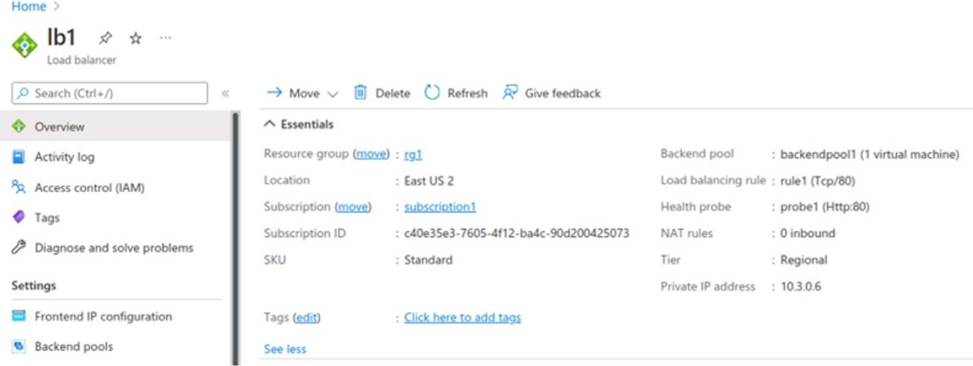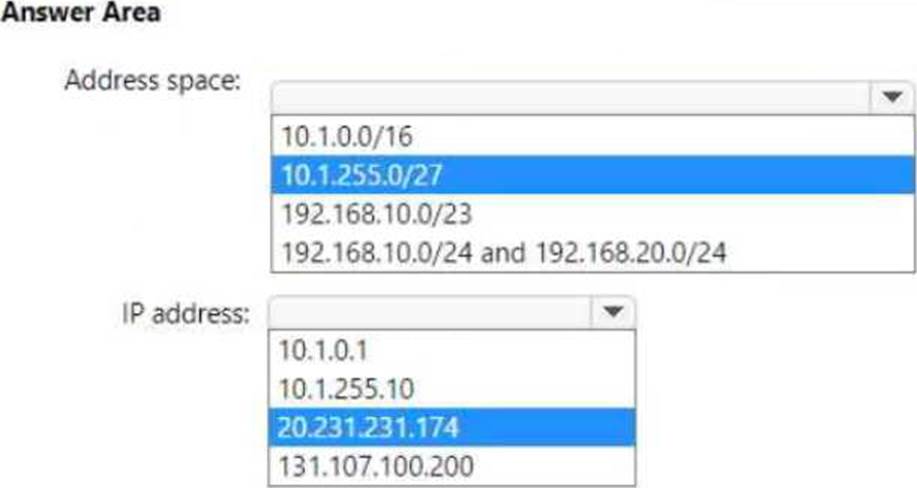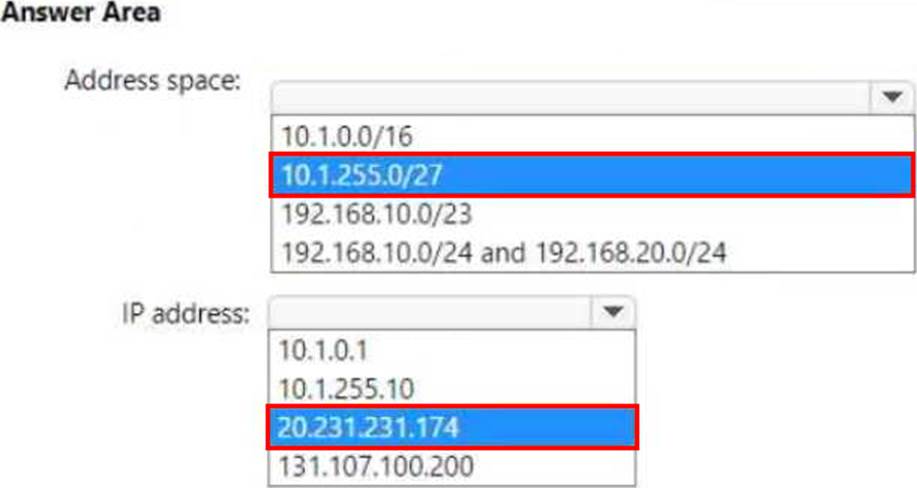Practice Free AZ-700 Exam Online Questions
You have an application named App1 that listens for incoming requests on a preconfigured group of 50 TCP ports and UDP ports.
You install App1 on 10 Azure virtual machines.
You need to implement load balancing for App1 across all the virtual machines. The solution must minimize the number of load balancing rules.
What should you include in the solution?
- A . Azure Standard Load Balancer that has Floating IP enabled
- B . Azure Application Gateway V2 that has multiple listeners
- C . Azure Application Gateway v2 that has multiple site hosting enabled
- D . Azure Standard Load Balancer that has high availability (HA) ports enabled
HOTSPOT
You have two Azure subscriptions named Subscription1 and Subscription2.
There are no connections between the virtual networks in two subscriptions.
You configure a private link service as shown in the privatelinkservice1 exhibit. (Click the privatelinkservice1 tab.)

You create a load balancer name in Subscription1 and configure the backend pool shown in the lb1 exhibit. (Click tie 1b1 tab.)

You create a private endpoint in Subscription2 as shown in the privateendpoint4 exhibit. (Click the privateendpoint4)

For each of the following statements, select YES if the statement is true. Otherwise. select No.

Topic 3, Mix Questions
You have an Azure virtual network that contains two subnets named Subnet1 and Subnet2. Subnet1 contains a virtual machine named VM1. Subnet2 contains a virtual machine named VM2.
You have two network security groups (NSGs) named NSG1 and NSG2. NSG1 has 100 inbound security rules and is associated to VM1. NSG2 has 200 inbound security rules and is associated to Subnet1.
VM2 cannot connect to VM1.
You suspect that an NSG rule blocks connectivity.
You need to identify which rule blocks the connection. The issue must be resolved as quickly as possible.
Which Azure Network Watcher feature should you use?
- A . Effective security rules
- B . Connection troubleshoot
- C . NSG diagnostic
- D . NSG flow logs
You plan to configure BGP for a Site-to-Site VPN connection between a datacenter and Azure.
Which two Azure resources should you configure? Each correct answer presents a part of the solution. NOTE: Each correct selection is worth one point. (Choose two.)
- A . a virtual network gateway
- B . Azure Application Gateway
- C . Azure Firewall
- D . a local network gateway
- E . Azure Front Door
You need to use Traffic Analytics to monitor the usage of applications deployed to Azure virtual machines.
Which Azure Network Watcher feature should you implement first?
- A . Connection monitor
- B . Packet capture
- C . NSG flow logs
- D . IP flow verify
HOTSPOT
Your on-premises network contains the subnets shown in the following table.

The network contains a firewall named FW1 that uses a public IP address of 131.107.100.200.
You have an Azure subscription that contains the resources shown in the following table.

You plan to configure a Site-to-Site (S2S) VPN named VPN1 that will connect GW1 to FW1.
You need to configure LNG1 to support VPN1.
The solution must meet the following requirements:
• Ensure that the resources on Subnet1 and Subnet2 can communicate with the resources on VNe1l.
• Minimize administrative effort.
How should you configure LNG1? To answer, select the appropriate options in the answer area. NOTE: Each correct selection is worth one point.

You have an Azure application gateway named AGW1 that has a routing rule named Rule1. Rule 1 directs traffic for http://www.contoso.com to a backend pool named Pool1. Pool1 targets an Azure virtual machine scale set named VMSS1.
You deploy another virtual machine scale set named VMSS2.
You need to configure AGW1 to direct all traffic for http://www.adatum.com to VMSS2.
The solution must ensure that requests to http://www.contoso.com continue to be directed to Pool1.
Which three actions should you perform? Each correct answer presents part of the solution. NOTE: Each correct selection is worth one point.
- A . Add a backend pool.
- B . Modify an HTTP setting.
- C . Add an HTTP setting.
- D . Add a listener.
- E . Add a rule.
You have an Azure virtual network that contains a subnet named Subnet1. Subnet1 is associated to a network security group (NSG) named NSG1. NSG1 blocks all outbound traffic that is not allowed explicitly.
Subnet1 contains virtual machines that must communicate with the Azure Cosmos DB service.
You need to create an outbound security rule in NSG1 to enable the virtual machines to connect to Azure Cosmos DB.
What should you include in the solution?
- A . a service tag
- B . a private endpoint
- C . a subnet delegation
- D . an application security group
Your company has a single on-premises datacenter in New York. The East US Azure region has a peering location in New York.
The company only has Azure resources in the East US region.
You need to implement ExpressRoute to support up to 1 Gbps. You must use only ExpressRoute Unlimited data plans. The solution must minimize costs.
Which type of ExpressRoute circuits should you create?
- A . ExpressRoute Local
- B . ExpressRoute Direct
- C . ExpressRoute Premium
- D . ExpressRoute Standard
You have an Azure subscription that is linked to an Azure Active Directory (Azure AD) tenant named contoso.onmicrosoft.com.
The subscription contains the following resources:
* An Azure App Service app named App1
* An Azure DNS zone named contoso.com
* An Azure private DNS zone named private.contoso.com
* A virtual network named Vnet1
You create a private endpoint for App1. The record for the endpoint is registered automatically in Azure DNS.
You need to provide a developer with the name that is registered in Azure DNS for the private endpoint.
What should you provide?
- A . app1.privatelink.azurewebsites.net
- B . app1.contoso.com
- C . app1.contoso.onmicrosoft.com
- D . app1.private.contoso.com


